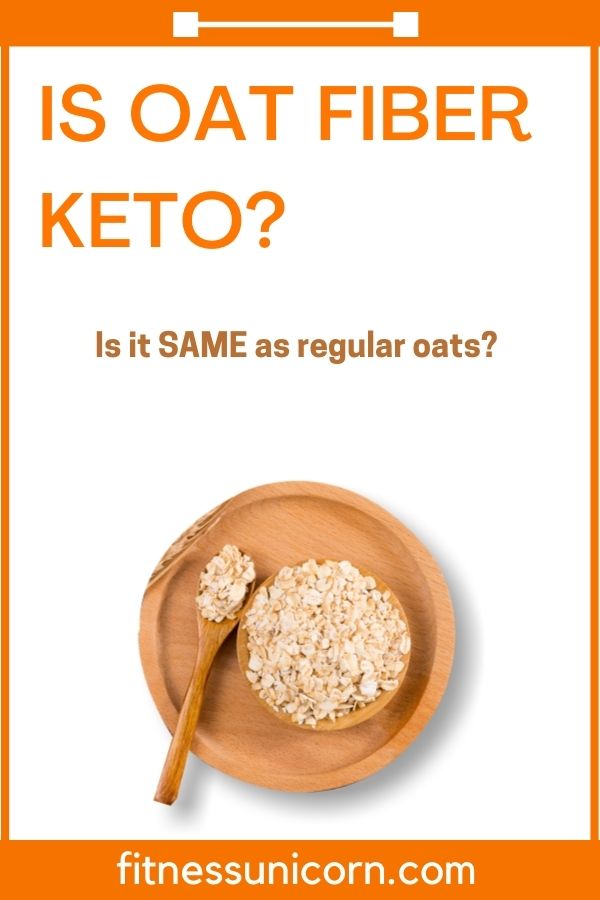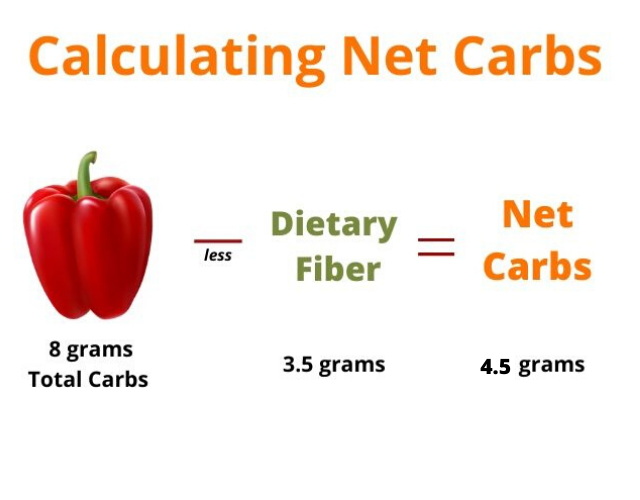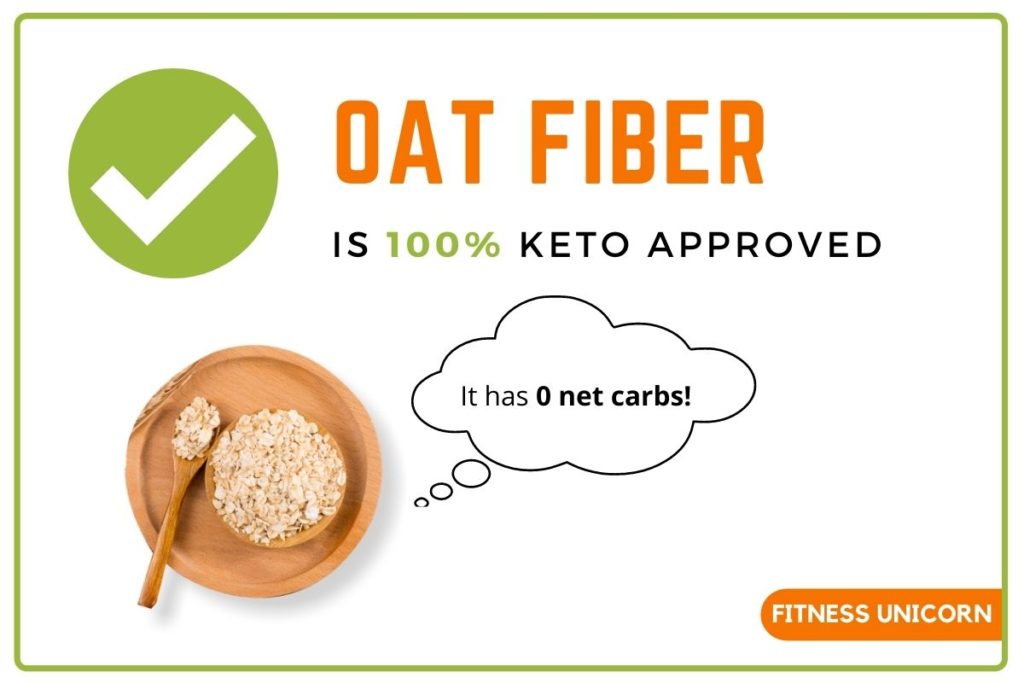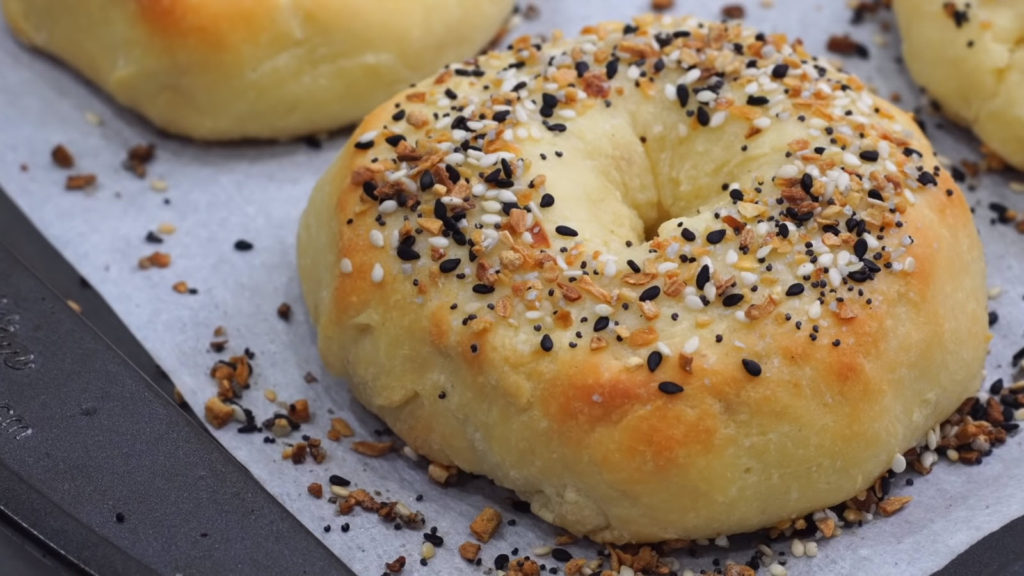All of us in the keto community look down upon grains of all kinds! But there has been a huge influx of oat fiber keto recipes on the internet! So, Is oat fiber keto?
I get tons of requests from people asking to review this ingredient! I guess the reason is that people are often confused between the regular oats and oat fiber, both of which greatly vary in terms of carbs!

Do not confuse oat fiber with oat bran, rolled oats, steel-cut oats, or any other variety of oats!
In this article, we will explore how oat fiber fits into the keto diet, its several health benefits, and the best ways to include it in your diet.
I’ll also share with you my favorite beginner-friendly keto oat fiber recipes!
Is Oat Fiber Keto Friendly?
Oat fiber is keto-friendly because all of its carbs are in the form of dietary fiber. Hence it has 0 net carbs per serving.
Oat fiber is technically just the fiber extracted from the oat grain! However, it is completely different in properties when compared to the oat kernel or oat bran.
Oat fiber is just an insoluble fiber and it is quite different from other grains as it does not contain any carbs, fats, or proteins.
Your daily carbohydrate consumption on a keto diet only considers the “net carbs” you eat and ignores the amount of dietary fiber.
Net carbs in a food item are determined by deducting the total number of carbs with the amount of dietary fiber present.
Here’s a quick example to show you how net carbs are calculated on the keto diet:

1 oz serving of Oat fiber has 27g of carbs but all of it comes from fiber. It simply means that oat fiber has 0 net carbs per serving!
MORE: Is Sauerkraut Keto Friendly?
What is Oat Fiber?
How is it possible to have a “grain” product with less than 1g of net carbs per 100g? Let’s find out what oat fiber is exactly made of!
It is quite overwhelming to hear about so many different types of oats: Rolled oats, steel-cut oats, quick-cooking oats, oat groats, oat bran, oat flour, oat fiber, etc.
But today let’s focus on the elephant in the room: Oat fiber.
Oat fiber is the outer shell of the whole oat grain. It is an indigestible fiber and does not give you any sort of macro or micronutrients.
Oat fiber is a byproduct of separating oat groats from the inedible hull.
Its only purpose in cooking is to enhance the flavor, texture, and quantity of your recipe and make it more satisfying and filling!
It can be a great addition to smoothies and shakes since it is an excellent thickener!
On top of it, it’s also an excellent source of dietary fiber. Experts recommend consuming at least 25 g of dietary fiber every day. According to a study, Americans are only consuming about 15 g as of 2020!
A single tablespoon of oat fiber on keto will easily add 9 g fiber to your diet.
Oat fiber can also be substituted for high-carb flours (e.g. wheat) to turn any recipe low-carb!
[Recommended: Are Boiled Peanuts Keto?]Why Use Oat Fiber on Keto
If you are on keto, oat fiber will be the perfect ingredient for your baking recipes! In fact, it can replace coconut flour in a 1:1 ratio because they both have similar properties.
Here are a few reasons why oat fiber is a part of many keto baking recipes:
- It can absorb water as much as 7 times its weight!
- Oat fiber prevents the foods from drying out and retains a good amount of moisture.
- Adding oat fiber is a smart hack to increase food quantity without increasing carbs!
- Since it’s high in fiber, it makes food highly filling and satisfying.
- It provides a host of health benefits (further discussed in this article)

My personal favorite reason to have oat fiber in keto recipes is that it drastically changes their taste and texture! I almost feel that it makes them kinda sweeter (without actual sugar!).
READ: Is Sesame Oil Keto?
Oat Fiber vs Oat Bran vs Oat Flour
These three are the most common types of oats that have confused a lot of people (me included!).
You’ll be amazed to know that all of them are derived from a single source, the Oat grain.
Oat grain has many different layers and each of them serves a different purpose, catering to different people.
Oat Bran
Oat Bran is the outer casing layer of the oat groat. When oat grains are processed, the exterior husk is removed leaving behind the oat kernel (a.k.a oat groat).
You can find the oat bran in both oat groats and the steel cut oats. The oat bran is removed from oatmeal to help it cook even faster.
Raw oat bran is often used in cold cereals, yogurt and smoothies. It is also used in breakfast porridge!
Oat bran is medium brown in color and has a strong flavor. It contains soluble fiber as opposed to the insoluble fiber present in Oat fiber.
In complete contrast to the oat fiber, oat bran still contains plenty of digestive macronutrients like fats, proteins and carbohydrates.
Oat bran is available in many particle sizes and you can use it to enhance texture and increasee moistness for soft and chewy items.
Oat Fiber
Oat Bran is the outer casing of an edible oat groat whereas oat fiber is derived from grinding the outermost layer of an oat grain (hull).
Oat fiber is very light in color and has a mild taste. It has very tiny particles and feels very smooth light in your hands, just like baking powder!
It’s water absorption properties greatly extend the shelf-life of any product and it’s also used for texturing the food.
This keto-friendly ingredient is perfect for retaining moisture while maintaining the crispiness of a recipe at the same time!
Oat fiber on keto is a great thickening agent for shakes, smoothies, etc. It adds a great crumbling texture to your keto desserts.
Oat Flour
Oat flour is the epitome of gluten-free baking! It is made by grinding the edible part of the oat grain, called the oat kernel (or oat groat).
You can think of oat flour as the grounded innermost layer of the oat grain when compared to oat bran or oat fiber.
Oat flour is a fairly modern ingredient that is rapidly gaining popularity now!
You can substitute as much as 25% of the all-purpose-flour with the oat flour without feeling any difference in taste or texture!
What’s the purpose, you may ask. Well, oat flour is much more nutrient-dense than white flour as it contains more fat and protein and fewer carbs.
You can make your own oat flour at home by simply grinding rolled oats into a thin powder.
If you are on the keto diet, stick with just the oat fiber and completely avoid the other two. Oat fiber has 0 net carbs and you can easily make it a part of your recipes to enhance taste, texture, and fiber intake.
Oat Fiber Benefits on Keto Diet
Oat fiber is a fantastic source of insoluble fiber on a keto diet! Ancient wisdom says that most of the human diseases stem from an unhealthy gut!
Having sufficient fiber is a sure-shot way of keepingyour digestive system healthy.
Oat fiber is an insoluble fiber made from the protective covering of oat kernetl. It is abundant in non-starch polysaccharides, which form small fibers in the digestive tract.
Insoluble fiber adds bulk to the stool which helps the food pass easily and efficiently through your intestines. It is also a good supplement to treat constipation.
From stablizing blood sugar levels to promoting heart health, here are the health benefits of oat fiber on keto:
Better Bowel Movement
The end of your large intestine is where water or other remaining nutrients and electrolytes are absorbed.
It is also known as the colon and it stores the healthy probiotics that aid digestion, provide vitamins, and prevents growth of bad bacteria.
There should be a free flow of food through the colon for optimum absorption. A good intake of insoluble fiber adds bulk to your stool and ensures smooth passage.
A diet lacking dietary fiber may lead to accumulation of waste materials in the colon!
Prevention Against Disease
A high-fiber diet can reduce the risk of diverticulitis (inflammation of the intestine), hemorrhoids, gallstones, kidney stones, relieve certain symptoms of irritable bowel syndrome (IBS).
Oat fiber on keto may also lower gastric acid and lower your risk of gastroesophageal reflux disorder (GERD) and ulcers.
Evidence suggests that eating a high-fiber diet can help prevent colorectal cancer, although the evidence lacks sufficient data. High fiber diets also lower the risks for digestive system cancers, including stomach, mouth, and pharynx.
Promotes Heart Health
Oat fiber can greatly boost heart health in humans.
A high fiber diet lowers your levels of bad cholesterol or LDL (low-density lipoprotein).
LDL gets a bad rep because it contributes to fatty buildups in arteries (atherosclerosis) and might even choke them.

Too much LDL cholesterol can cling to the walls of your blood vessels. This accumulation is called “plaque.” As more and more cholesterol accumulates over your blood vessels, their insides narrow.
This causes obstruction in the blood flow path going from the heart to other organs.
Sufficient intake of the fiber reduces your risk of metabolic syndrome, a group of risk factors linked to coronary heart disease, diabetes, and stroke.
Fiber helps to lower blood pressure, reduce bodily inflammation, increase good cholesterol (HDL), and aid weight loss.
Reduces Blood Sugar Spikes
As per CDC, “More than 30 million people in the United States have diabetes, and 1 in 4 of them don’t know they have it.”
Oat fiber is a source of insoluble fiber that does not raise your blood sugar levels. It has a glycemic index of 0 as it is not absorbed by the body.
A diet rich in insoluble fiber can significantly lower your risk of type 2 diabetes. Many people suffering from type 2 diabetes pick up the lchf diet or keto diet to stabilize blood sugar.
Promotes Healthy Gut
The word “bacteria” often has a negative connotation to it! We always imagine bacteria to be something gross and unhealthy.
However, there exists “good bacteria” as well which keeps your gut healthy and aids digestion. Other than just increasing the bulk of stool, oat fiber also improves gut health.
Gut health is important to absorb all the fats, carbs, proteins, and micronutrients from the food. It also requires the “good bacteria” for proper absorption.
And guess what? The bacteria in your colon loves to feed on the insoluble fiber or oat fiber.
With so many benefits in its arsenal, oat fiber should definitely make it to your keto ingredient list!
RECOMMENDED: Is Mission Carb Balance Keto?
Oat Fiber Alternative on Keto
We just saw how wonderful oat fiber can be on a keto diet!
It has effectively 0 net carbs and the insoluble fiber is a blessing to our health and digestive system! But what if you aren’t able to get your hands on it?
Whether oat fiber is out of stock in your nearby store, or you simply want an alternative to try on the keto diet, Psyllium Husk is the best choice.
Psyllium husk powder is vastly considered as a great fiber supplement to your diet.
It closely resembles the wood shavings in texture and feels very light! Mixing it in water makes a very gelatin-like substance.
Psyllium is similar to Oat fiber in a way that they both have high amounts of fiber and very few net carbs. However, Oat fiber contains insoluble fiber while Psyllium husk is rich in soluble one.
Psyllium can also be used in keto recipes to increase moisture in baked goods. It can relieve some of the keto-flu symptoms such as constipation.
Oat Fiber Keto Bread Recipe
Here are some of my all-time favorite keto recipes made with oat fiber!
They are super low in carb and rich in dietary fiber that makes them one of the healthiest keto recipes in my handbook!
Keto Pizza Bagels
We all sometimes crave for a thin crust pizza on a low carb diet! But since carbs are out of the equation, we are often left with no option than turning away our faces!
These Keto pizza bagels can rightly serve those cravings in a more low-carb way that won’t mess with your ketosis!

They are made with fathead dough made out of our star ingredient: Oat fiber.
Each serving of these keto pizza bagels contains 140 calories and just 2 g of net carbs, which is excellent as per keto standards!
Here are the recipe ingredients:
- 1 1/2 cup mozzarella shredded
- 2 oz cream cheese
- 1/2 cup oat fiber
- 1 teaspoon baking powder
- 1 tablespoon oregano
- 1 medium egg
- 1/2 teaspoon salt
- 1/2 cup marinara sauce
- 3/4 cup mozzarella
- 8 black olives sliced
Get the complete recipe at Divalicious Recipies
Oat Fiber Keto Pancakes
Damn I want some pancakes!
That’s what you can’t wish in the keto diet! But what if there’s a workaround to enjoy the goodness of pancakes without enormous amounts of carbs?
These keto buttermilk pancakes are made with oat fiber, which effectively has 0 net carbs!
You can further lower the net carbs in this recipe by substituting the buttermilk with a combination of almond milk and vinegar.
It is quite a beginner-friendly recipe and requires the following ingredients:
- Oat fiber
- Almond flour
- Baking powder
- Salt, buttermilk
- Coconut oil
- Eggs
Get the complete recipe at Low Carb Yum
Beware: The fresh aroma from these pancakes might tempt you into going with sugar-laden toppings! A great low carb alternative can be dark chocolate chips.
Conclusion
Is oat fiber keto?
Oat fiber is keto-friendly because it has 0g of net carbs and all of the carbs come from fiber. Fiber has a 0% glycemic index and it does not affect ketosis in any way.
It is an insoluble fiber that has a very mild taste and absorbs 7 times water to its weight. That’s why it is heavily used in many keto baked recipes. A high fiber diet prevents you from blood sugar spikes, improves digestion, and also lowers bad cholesterol.
Do not confuse oat fiber with other oat varieties such as oat bran, rolled oats, steel-cut oats, etc.
